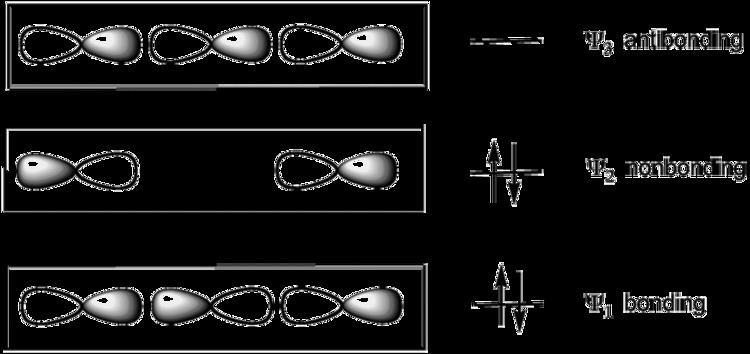 | ||
The 3-center 4-electron bond is a model used to explain bonding in certain hypervalent molecules such as tetratomic and hexatomic interhalogen compounds, sulfur tetrafluoride, the xenon fluorides, and the bifluoride ion. It is also known as the Pimentel–Rundle three-center model after the work published by George C. Pimentel in 1951, which built on concepts developed earlier by Robert E. Rundle for electron-deficient bonding. An extended version of this model is used to describe the whole class of hypervalent molecules such as phosphorus pentafluoride and sulfur hexafluoride as well as multi-center pi-bonding such as ozone and sulfur trioxide.
Contents
Molecular orbital theory
The model considers bonding of three colinear atoms. For example, in xenon difluoride (XeF2), the linear F−Xe−F unit is described by a set of three molecular orbitals (MOs) derived from colinear p-orbitals on each atom. The Xe−F bonds result from the combination of a filled p orbital in the central atom (Xe) with two half-filled p orbitals on the axial atoms (F), resulting in a filled bonding orbital, a filled non-bonding orbital, and an empty antibonding orbital. The two lower energy MO's are doubly occupied. The bond order for each Xe-F bonds is 1/2, since the only bonding orbital is delocalized over the two Xe-F bonds.
The HOMO is localized on the two terminal atoms. This localization of charge is accommodated by the fact that the terminal ligands are highly electronegative in hypervalent molecules. The linear F−A−F axis of the molecules SF4 and ClF3 is described as a 3-center 4-electron bond. In the xenon fluorides, all bonds are described with the 3-center 4-electron model. Molecules without an s-orbital lone pair such as PF5 and SF6 are described by an extended version of the 3-center 4-electron model (See hypervalent molecule).
Valence bond theory
The bonding in XeF2 can also be shown qualitatively using resonant Lewis structures:
[ F–Xe F– ↔ F– Xe–F ]In this representation, the octet rule is not broken, the bond orders are 1/2, and there is increased electron density in the fluorine atoms. These results are consistent with the molecular orbital picture discussed above.
Hypervalent description with d orbitals
Older models for explaining hypervalency invoked d orbitals. As of 2010, these models still appear in some beginning-level college texts; however, quantum chemical calculations suggest that d-orbital participation is negligible due to the large energy difference between the relevant p (filled) and d (empty) orbitals. Furthermore, a distinction should be made between "d orbitals" in the valence bond sense and "d functions" that are included in the QM calculation as polarization functions. The 3-center-4-electron bonding model has the advantage of dispensing with the need for d orbitals, which has led to its acceptance.
Other systems
Three-center four-electron interactions can also be considered in the transition state of SN2 reactions and in some (resonant) hydrogen bonding (as in the bifluoride anion):
[ F–H F– ↔ F– H–F ]